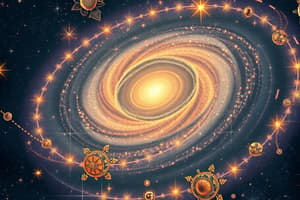Podcast
Questions and Answers
Which type of galaxy is characterized by a bulge, a disk, and a halo?
Which type of galaxy is characterized by a bulge, a disk, and a halo?
- Elliptical Galaxy
- Irregular Galaxy
- Spiral Galaxy (correct)
- Spherical Galaxy
What characteristic is true of stars in an elliptical galaxy compared to those in a spiral galaxy?
What characteristic is true of stars in an elliptical galaxy compared to those in a spiral galaxy?
- They tend to be older than spiral galaxy stars. (correct)
- They are distributed more uniformly than in spiral galaxies.
- They are typically brighter than spiral galaxy stars.
- They are generally younger than spiral galaxy stars.
What is the primary reason that irregular galaxies lack a clear and defined shape?
What is the primary reason that irregular galaxies lack a clear and defined shape?
- They are formed in isolation from other celestial bodies.
- They are influenced solely by dark matter.
- They may have experienced gravitational forces or collisions. (correct)
- They usually contain fewer stars than other galaxy types.
How are elliptical galaxies typically described in terms of their shape?
How are elliptical galaxies typically described in terms of their shape?
What defines the classification of irregular galaxies?
What defines the classification of irregular galaxies?
A ______ galaxy contains a bulge, a disk, and a halo.
A ______ galaxy contains a bulge, a disk, and a halo.
The stars in an ______ galaxy tend to be older than those in a spiral galaxy.
The stars in an ______ galaxy tend to be older than those in a spiral galaxy.
Irregular galaxies lack the clearly defined shape of ______ and elliptical galaxies.
Irregular galaxies lack the clearly defined shape of ______ and elliptical galaxies.
Elliptical galaxies can vary greatly in ______.
Elliptical galaxies can vary greatly in ______.
The formation of galaxies is primarily due to the force of ______.
The formation of galaxies is primarily due to the force of ______.
Flashcards
Spiral Galaxy
Spiral Galaxy
A galaxy with a bulge, disk, and halo, brightest near the center.
Elliptical Galaxy
Elliptical Galaxy
An elongated sphere-shaped galaxy, often with older stars.
Irregular Galaxy
Irregular Galaxy
A galaxy without a defined shape or symmetry, often small and deformed.
Galaxy Formation
Galaxy Formation
Signup and view all the flashcards
Galaxy
Galaxy
Signup and view all the flashcards
What are the three main types of galaxies?
What are the three main types of galaxies?
Signup and view all the flashcards
Study Notes
Galaxy Definitions
- A galaxy is a collection of stars, interstellar gas, dust, and remnants of stars, all bound together by gravity.
Types of Galaxies
- Spiral Galaxy: A galaxy containing a bulge, a disk, and a halo. Stars are brightest near the center and less bright at the edges. Stars in spiral galaxies tend to be younger than those in elliptical galaxies.
- Elliptical Galaxy: Shaped like an elongated sphere, a bright mass of stars. Stars are brightest near the center and less bright toward the edges. Elliptical galaxies vary greatly in size; stars within are generally older than those in spiral galaxies.
- Irregular Galaxy: A galaxy that lacks the defined shape and symmetry of spiral or elliptical galaxies. They are usually smaller than the other two types. Their shape can be the result of uneven gravitational forces or collisions with other galaxies, causing them to deform.
Galaxy Formation
- Gravity pulls matter together from nearby matter.
- The force of gravity becomes intense, causing stars to form within these clumps.
- Small star clusters fill the universe.
- These clusters of stars attract and combine with other clusters, ultimately forming galaxies.
Studying That Suits You
Use AI to generate personalized quizzes and flashcards to suit your learning preferences.




